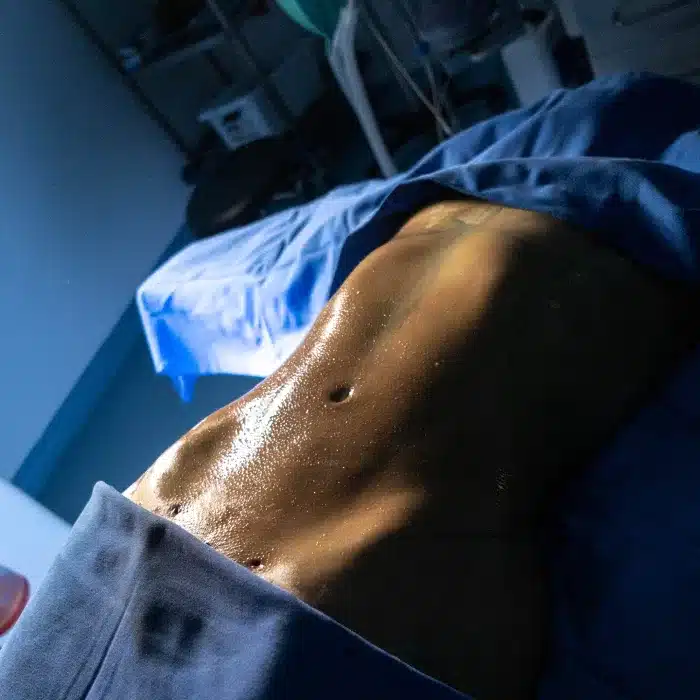Key Takeaways
- Male liposuction focuses on shaping common areas to eliminate fat deposits. This procedure assists in achieving a more defined and chiseled appearance, particularly in the area of the abdomen, chest, and sides.
- As beauty standards for both genders are changing, male liposuction continues to increase in popularity. It’s great to see more men embracing cosmetic procedures to enhance their self-improvement and body confidence.
- Male and female liposuction differ in fat distribution patterns, aesthetic goals, and recovery experiences, highlighting the need for gender-specific approaches to these procedures.
- Ideal candidates for male liposuction are men who are healthy and near their ideal weight. They too have localized fat deposits and are committed to preserving their outcome long-term post-op.
- Recovery from liposuction requires following aftercare instructions, using compression garments, and allowing time for swelling and bruising to subside for optimal results.
- Male liposuction trends have the potential to influence social markers of beauty and negatively affect women’s body image. This underscores the importance of promoting body positivity to all people, regardless of gender.
The growing demand for liposuction among men signifies that cosmetic procedures for men have entered the mainstream, testament to changing attitudes and perceptions towards self-care and appearance among males. That’s because more men are choosing this option to remove stubborn pockets of fat.
More often than not, they focus on their belly, chest, and love handles. This trend speaks to an increasing awareness of body image concerns as well as the desire to attain confidence through aesthetic improvements. For women, it starts important conversations about collective beauty ideals and changing views on gender roles in the cosmetic industry.
These non-invasive procedures are soaring in popularity. They stress the importance of exploring what men and women are seeking and getting from the procedure. Examining this issue reveals the ways that larger societal trends affect individual choices and reshape the realities of what we’re all expected to look like.
What Is Liposuction
Liposuction, called lipectomy, is a cosmetic surgery that eliminates unwanted fat. It is used to contour the body, or target specific areas, with a minimally invasive technique. While it is not a weight-loss solution, it targets stubborn fat that resists diet and exercise, offering a more defined and contoured appearance.
For men, liposuction is becoming a more common procedure because it addresses their specific aesthetic needs and physique.
Define Liposuction for Men
Male liposuction is a custom fat removal procedure designed specifically for the unique anatomical structure of men. This technique emphasizes improving body contour in areas such as the abdomen, chest, and flanks to achieve a leaner, more sculpted appearance.
The main purpose is to obtain a more naturally athletic appearance by eliminating stubborn fat stores. Surgeons take into account the differences in skin thickness and fat density in men to ensure precision and optimal results.
For example, gynecomastia—an accumulation of fat in the chest area—is a frequent concern for male patients.
Explain How It Differs for Men
Men and women store fat in different patterns, which affects how the procedure is performed. Men tend to store fat in the abdomen, which makes the abdominal region a priority during liposuction.
Their aims often focus more on a sculpted, chiseled appearance than the hourglass shape that many female patients desire. Recovery will be different as male fat is more fibrous, which can cause swelling to last longer and hence prolong healing time.
Highlight Benefits of Liposuction
Not only does liposuction provide men with a number of physical benefits, such as a more defined body shape, it boosts their self-confidence. When followed by consistent weight maintenance, changes may be permanent, frequently resulting in improved psychological health.
Research shows that more than 60% of men say they feel better about their appearance after the procedure. While recovery usually allows light activities within days, full healing could take several weeks, making it a manageable option for busy lifestyles.
Growing Popularity Among Men
This increase in male liposuction is indicative of a larger societal shift in how men view their bodies and care for themselves. Cosmetic procedures have been growing in popularity among men as well. According to the American Society of Plastic Surgeons, they’re increasingly choosing these procedures to enhance their looks and self-assurance.
Cultural norms are shifting quickly, and the fitness landscape is changing right along with it. Social media and celebrity culture are furthering this trend in a big way.
Increasing Demand for Male Liposuction
Statistics show a dramatic rise in male liposuction procedures recently. Younger men in their 20s and 30s are leading the charge on this trend. For some, it is a means of self-actualization, connoting an emphasis on aesthetics as an element of contemporary manhood.
With a sculpted, concise midsection, liposuction exposes muscle definition and boosts overall body self-assurance. Platforms like Instagram heighten this demand, flooding timelines with the before and afters, making the procedure seem routine, and further promoting the trends.
Societal Shifts in Male Body Image
Cosmetic surgery used to be a strictly feminine practice, but modern masculinity has incorporated aesthetics and body positivity, increasing stigma around cosmetic enhancements. Fitness culture has changed the game when it comes to body image, pressuring men to match their bodies to athletic standards.
Today, that number has grown to one in five men in the U.S. Considering cosmetic surgery. This trend illustrates a positive growing acceptance and reduction in stigmatization surrounding these lifestyle choices.
Reasons Behind the Trend
Body dissatisfaction among men has tripled in just 25 years and liposuction provides a tangible solution. Fitness fads and social pressures drive men to achieve chiseled appearances, when better body image can reduce risk of depression by 50%.
In fact, research indicates that 61% of men experience greater confidence after having liposuction.
Trends And Statistics
The increasing popularity of cosmetic procedures among men is a trend no longer in the shadows. Liposuction is more popular now than ever—with a recent spike among men. More and more are opting to undergo this procedure to align their physical appearance with their inner selves—and their career goals.
This change represents a broader shift in attitudes about body image and wellness. It’s not just hurting men; it’s hurting our entire society.
Present recent data on male liposuction
According to recent statistics, the number of male liposuction procedures has increased by 20% in just the last several years. In 2022 alone, almost 19,275 men had the procedure, primarily on the abdomen, chest and flanks.
The table below illustrates key data:
| Procedure Area | Percentage of Cases |
|---|---|
| Abdomen | 65% |
| Chest (Gynecomastia) | 35% |
| Flanks | 20% |
Male breast reduction surgeries have increased by 35%, a testament to the increased awareness of gynecomastia treatments. This data further highlights a male priorities towards body contouring as a new form of self-care.
Compare male and female liposuction rates
If we look specifically at the rate of liposuction per gender, we find that men account for 11% of all liposuction cases. In stark contrast, women make up 89% of the rest.
When it comes to treatment, disparities begin to show up. Women typically aim to lose fat around the thighs, hips, and arms, while men may want to lose fat from around the abdomen and chest.
| Gender | Common Areas Treated | % of Total Procedures |
|---|---|---|
| Men | Abdomen, Chest | 11% |
| Women | Thighs, Hips, Arms | 89% |
These differences are informed by culture’s ideals of beauty and shifting definitions of masculinity and femininity. Male liposuction challenges these outdated perceptions, opening the door for a more inclusive approach to cosmetic enhancement.
Analyze age and demographic patterns
The most common liposuction candidates are men between the ages of 30 and 50. This cohort frequently juggle hectic schedules along with health ambitions, and oftentimes consider the procedure an added mechanism to complement their endeavors.
Lifestyle factors, including an increased focus on fitness and health and growing career ambitions, play a large role in this trend as well.
Additionally, liposuction successfully sculpts the body, as one to three pounds of fat can be removed. This makes it an ideal choice for anyone who has reached a standstill in their weight loss progress or exercise regimen.
Since most men only take a week off work, it’s a convenient option for busy professionals. Targeted marketing efforts can help turn that interest into action. By emphasizing the positive impacts on self-esteem and overall wellness, we can connect these more niche demographics.

Candidacy For Male Liposuction
Male liposuction is on the rise, as more men desire a more chiseled appearance and boost their self-esteem. This is the one procedure that knocks out that stubborn fat. It is important to understand who is a candidate for it and what things can affect your results.
The ideal candidate is likely to have better results when the procedure is suited to their goals and lifestyle. This alignment supports physical and mental health and readiness.
Discuss Ideal Candidates for the Procedure
The ideal male liposuction candidates are those who are close to their ideal body weight, preferably within 30% of it. They have isolated pockets of fatty tissue that are unresponsive to diet and exercise. Firm, elastic skin is key for a smooth, post-surgery appearance, as it allows for optimal contouring.
Younger men, especially those in their 20s and 30s, usually see the most impressive results thanks to increased skin elasticity and faster recovery times. For men, the procedure often targets the abdomen, chest, and flanks with the intent of creating more defined, angular results.
Beyond being physically ready, you have to be mentally prepared. Candidates need to be in touch with their own body image and have realistic expectations of what liposuction can do. It isn’t dramatic weight loss, but it is improvement of the natural shape.
Commitment to a stable weight and healthy habits post-surgery ensures long-term results, making this a collaborative effort between the patient and their surgeon.
Explain Health and Fitness Prerequisites
Good health is a starting point. Chronic illnesses, such as uncontrolled diabetes or heart disease, increase the risk of surgery and recovery. A healthy lifestyle, with consistent exercise and proper nutrition, helps make the procedure safer.
It makes a big difference in the final outcomes. As an illustration, a person who is already committed to a strength training routine might have a more toned look following liposuction.
Fitness is an important component to recovery and results. Men who have toned muscles and tighter skin elasticity typically end up with better results. The procedure is typically to enhance an already great physique.
If you’re interested in ultrasound-assisted liposuction (UAL), make sure you’re in good health. This increases the accuracy and safety of more advanced techniques such as Vaser liposuction.
Highlight Factors Influencing Eligibility
There are a number of factors that determine eligibility. Skin elasticity plays a big role. Skin that is firmer and more elastic adapts more easily to the new contours, lowering the chance of sagging.
Fat distribution plays an important role as well. Disproportionate or excessive deposits can necessitate different, more customized methods. Past surgeries or medical conditions may affect eligibility, so an in-depth consultation with a board-certified plastic surgeon is crucial.
After consultation, we decide together what is best for the individual. A customized evaluation may determine best approaches based on skin quality, fat composition, and medical history.
This will help ensure that the procedure is customized to each person’s needs, maximizing safety and satisfaction.
Candidacy for Male Liposuction Patients should budget for the cost of the procedure. The price difference is significant, anywhere from $3,000 to $15,000 depending on the areas treated.
The healing process, while steady, does take a few months so patience and compliance with post-operative care is a must.
Procedure Details For Men
This is the reason liposuction for men has increased in popularity, as they seek a more chiseled look. It does a remarkable job of flushing out hard-to-reach fat pockets that are resistant to diet and exercise.
It’s a comprehensive procedure that requires meticulous planning, state-of-the-art technology, and a precision approach that’s sensitive to targeted treatment areas designed for male physiques.
Outline Preparation Steps Before Surgery
As a surgical procedure, preparation is the key to obtaining the best possible outcome. Essential steps include:
- Surgeons take into account overall health, past surgeries, and other existing conditions.
- Candidates may need to reduce sodium intake or maintain a balanced diet pre-surgery.
Certain medications or supplements, like blood thinners, might be paused. Quitting smoking, and staying away from alcohol allow for proper healing.
Carefully adhering to these steps with a surgeon’s expertise reduces the risk of complications and improves the results.
Explain Procedure Techniques for Men
Liposuction techniques are specifically focused on the male body, where fat is typically drier and denser. An approach called tumescent liposuction involves injecting a fluid mixture to minimize bleeding and pain.
Vaser lipo uses ultrasound technology to gently dissolve and remove fat, allowing for highly-precision sculpting that is perfect for the male chest.
State-of-the-art options such as liposculpture provide quicker recovery and more natural results than older techniques. Men tend to return to very light activity in a week!
Detail Areas Commonly Treated in Men
The most targeted areas include:
- Abdomen and Flanks: Popular for creating a leaner waistline.
- Chest: Helps with gynecomastia or excess fat.
- Back and Arms: Addresses stubborn fat deposits.
- Thighs: Improves proportion.
Each area usually requires the removal of one to three pounds of fat, at a cost of $3,000–$7,500 per area.
Recovery And Aftercare Expectations
Liposuction recovery is an important process that should be approached with patience and care. While individual experiences may vary, understanding the recovery timeline and following aftercare instructions can significantly impact the liposuction results and help achieve the desired body contours.
Describe Post-Surgery Recovery Process
Recovery often happens in predictable stages. In the first few days, swelling, bruising, and tenderness are expected. These symptoms can last two to three weeks but subside over time.
Swelling may persist for several weeks, and full recovery usually requires at least three months. Men typically go back to work after one week, but vigorous physical activities should be avoided during the early recovery period.
Gradually, patients can return to light activity, with a return to full activity by two to three weeks. Final results typically become apparent three to six months following the surgery. Screening for complications, like infection or atypical pain, becomes very important during this timeframe.
Highlight Aftercare Tips for Optimal Results
- Follow guidelines for wearing compression garments to reduce swelling and help tissue heal properly.
- Stay hydrated to aid recovery and maintain overall health.
- Minimize physical exertion, including vigorous exercise for a minimum of two weeks.
- Attend follow-up appointments for professional monitoring.
- Keep the surgical area clean and adhere to wound care instructions very carefully.
Discuss Potential Risks and Complications
Like any surgical procedure, liposuction has risks, including severe infection, scarring, or uneven results. Though these are unusual when done by an experienced surgeon, knowing what may go wrong is important.
These risks are dramatically lowered when work is performed by an experienced professional, leading to safer outcomes.
Implications For Women
The increase in male liposuction trends not only continues to redefine male standards but also has significant implications for women. Today, more men than ever are embracing cosmetic procedures like male liposuction surgery, prompting women to rethink their notions of beauty and adapt to the evolving beauty standards imposed by society.
Explore influence on women’s body image
When men become public figures for liposuction, it shifts the conversation in an insidious way to what women should look like to be attractive. When men put time and money into chiseled physiques, it creates an expectation. This can create the expectation for women to uphold and even exceed societal standards of beauty.
This can increase the already strong societal pressure to achieve a specific “ideal” appearance. This presents exciting opportunities to teach and promote body positivity for all. Let’s celebrate one another and keep reminding everyone that self-love is about much more than just how we look.
Fostering acceptance of a healthy body, no matter what shape or size, should be a priority for all.
Discuss impact on societal beauty standards
Changing standards of beauty are always a threat to conservative views of gender roles and the concept of masculinity and femininity. Male liposuction services are on the rise. This trend has the potential to usher in a more inclusive, realistic, and empowering definition of beauty that embraces all body types.
For women, this can have the effect of creating more flexible structures, although the process is not without its challenges. A bigger conversation around beauty will be important to make sure these changes aren’t creating new acceptance but new pressure.
Highlight shared challenges in cosmetic surgery
Men share many of the same but different complications as women with their cosmetic procedures. Stigma is still a collective weight, frequently shaming users everywhere from discussing their impact on self-image.
There’s the emotional and physical toll, from the recovery process—which includes swelling and tenderness lasting weeks—to managing expectations about outcomes. This kind of challenge underscores the need to confront beauty ideals in ways that emphasize self-acceptance and diminish condemnation.
Conclusion
It’s clear that liposuction has become much more than a beauty decision for women. That’s right—men are increasingly seeking out this procedure to achieve targeted body goals. The increase in male liposuction is a sign that attitudes toward self-care and body image are evolving. It’s not about following trends, but about doing what is right for your own confidence and well-being. Women, too, stand to gain from this change, as it expands the conversation around beauty and wellness.
Knowing what to expect from the process, recovery, and results allows you to make the best decisions possible. Whether you’re thinking about getting the procedure yourself, or helping someone else, being in the know is half the battle. Keep your expectations in check, seek out professionals you can trust, and go with whatever makes you feel best and most comfortable.
To read more helpful information and other related topics, check out our blog! Keeping yourself in the know is the first step toward making decisions that better suit your life.
Frequently Asked Questions
What is liposuction for men?
Liposuction for men is a male-focused cosmetic procedure that effectively targets stubborn, unwanted fat, particularly in areas like the abdomen, chest, and flanks. This body contouring procedure not only sculpts the physique but also promotes a truer masculine definition, enhancing body confidence.
Why is liposuction becoming popular among men?
Increasingly, men are turning to liposuction trends as a way to achieve a toned appearance and feel more confident. Social media, fitness trends, and improved beauty standards all contribute to its rising popularity.
What areas can men target with liposuction?
The most popular areas for male liposuction include the chest, often addressing gynecomastia, abdomen, flanks, and neck, where resistant fat accumulates despite diet and exercise efforts, highlighting current liposuction trends.
Who is a good candidate for male liposuction?
The best candidates for male liposuction are men who are in overall good health, near their ideal weight, and have localized fat deposits. This cosmetic procedure isn’t a weight-loss treatment; it’s designed for body contouring.
How long is the recovery for male liposuction?
Most people take 1–2 weeks to recover from liposuction procedures. Most men, especially those seeking male lipo, are back to light activities in just a few days and return to working out in about 4–6 weeks.
How does male liposuction benefit women?
The rise in male liposuction trends reduces the stigma around cosmetic surgery, encouraging more women to explore their own options for achieving body confidence and sculpted body contours.
Is liposuction safe for men?
Yes, absolutely, and when performed by a qualified plastic surgeon, liposuction trends show that risks are minimal, as long as you have the correct care. Ensure you select a highly experienced provider to guarantee both safety and optimal liposuction results.










